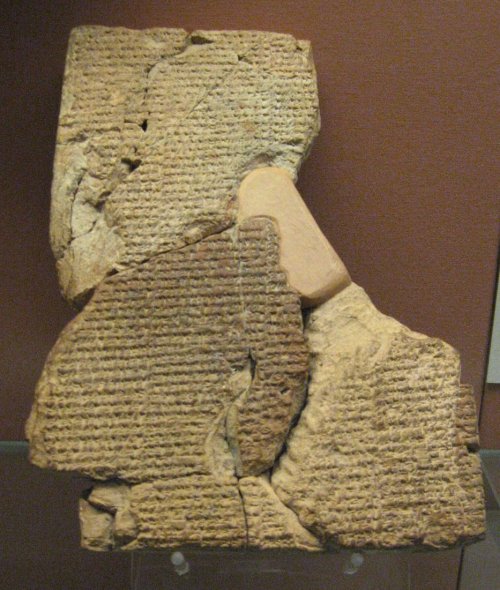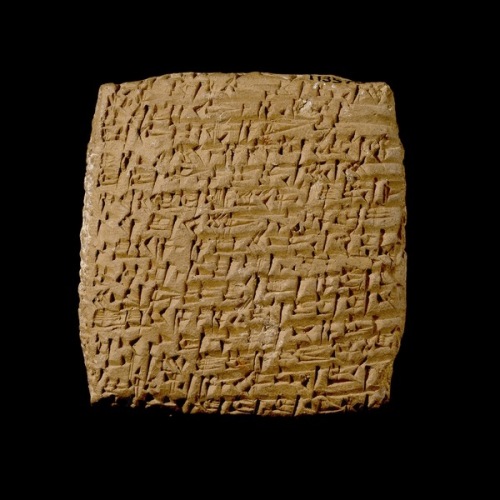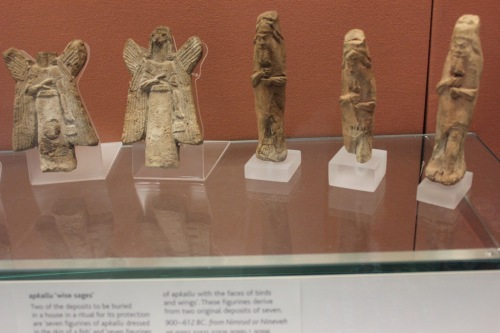Melvin: On the Role of Divine Counsel
“Elements of civilization are also attributed to the semi-divine hero, Gilgamesh. The opening lines of the Epic of Gilgamesh celebrate his great wisdom:
“He who saw the Deep, the country’s foundation, [who] knew…, was wise in all matters! [Gilgamesh, who] saw the Deep, the country’s foundation, [who] knew…, was wise in all matters! [He …] everywhere […] and [learnt] of everything the sum of wisdom. He saw what was secret, discovered what was hidden, he brought back a tale of before the Deluge.”
(The Epic of Gilgamesh, SBV I.1–8 (Andrew George, The Epic of Gilgamesh: A New Translation [London: Penguin, 2000], p.1).
The text goes on to describe Gilgamesh’s achievements in building the edifices of the city of Uruk, especially its wall. Here the text highlights the great wisdom required for such construction by ascribing the foundations of the city wall to the wisdom of the “Seven Sages” (apkallus).

Cuneiform tablet with the Atrahasis Epic.
Babylonian, about 17th century BCE.
From Sippar, southern Iraq.
A version of the Flood story.
The story outlines the structure of the universe according to Babylonian beliefs. Heaven is ruled by the god Anu, the earth by Enlil and the subterranean sweet water by Enki. The text then explains how the minor gods work in the fields but then rebel. As a result, humans are made from clay, saliva and divine blood to act as servants of the gods.
This does not prove a perfect solution, as the humans reproduce and their noise disturbs Enlil’s sleep. He decides to destroy them with plague, famine, drought and finally a flood.
However, each time Enki instructs one of the humans, Atrahasis, to survive the disasters. The god gives Atrahasis seven days warning of the flood, and he builds a boat, loads it with his possessions, animals and birds. He is subsequently saved while the rest of humankind is destroyed.
However, the gods are unhappy as they no longer receive the offerings they used to.
There is a gap in the text at this point but it does end with Atrahasis making an offering and Enlil accepting the existence and usefulness of humans.
Copies of this story have survived from the seventeenth to the seventh century BCE showing that it was copied and re-copied over the centuries. This is the most complete version. There are clear similarities between this Flood story and others known in Mesopotamian literature, for example, the Epic of Gilgamesh.
T.C. Mitchell, The Bible in the British Museum (London, The British Museum Press, 1988)
S. Dalley, Myths from Mesopotamia (Oxford University Press, 1991)
W.G. Lambert and A.R. Millard, Atra-hasis (Oxford, Clarendon Press, 1969)
http://www.britishmuseum.org/explore/highlights/highlight_objects/me/c/cuneiform_the_atrahasis_epic.aspx
Moreover, within the epic, the greatest achievements of Gilgamesh are the building of the wall of Uruk and the wisdom he obtained and passed on to subsequent generations.
(Jeffrey H. Tigay, The Evolution of the Gilgamesh Epic (Phildelphia: University of Pennsylvania Press, 1982), pp.142–49; 213.)
The source of this wisdom is his encounter with the divinized Flood hero, as the Sumerian text The Death of Bilgames indicates:
“…you reached Ziusudra in his abode! The rites of Sumer, forgotten there since distant days of old, the rituals and customs—it was you brought them down to the land. The rites of hand-washing and mouth-washing you put in good order, [after the] Deluge it was you made known all the tasks of the land […].”
(The Death of Bilgames, M 57–62 (George, The Epic of Gilgamesh, pp.198– 99).
Thus, Gilgamesh acts as a mediating figure between the divine source of the knowledge necessary for aspects of civilization and the people of Sumer. The source of his divine knowledge is the divinized Flood hero, who had in turn received his knowledge from Enki / Ea, as well as perhaps his divine mother, Ninsun.

Library of Ashurbanipal / The Flood Tablet / The Gilgamesh Tablet
Date 15 July 2010
Current location: British Museum wikidata:Q6373
Source/Photographer Fæ (Own work)
Other versions File:British Museum Flood Tablet 1.jpg
British Museum reference K.3375
Detailed description:
Part of a clay tablet, upper right corner, 2 columns of inscription on either side, 49 and 51 lines + 45 and 49 lines, Neo-Assyrian, Epic of Gilgamesh, tablet 11, story of the Flood. ~- Description extract from BM record.
Location Room 55
https://commons.wikimedia.org/wiki/File:Library_of_Ashurbanipal_The_Flood_Tablet.jpg
(See Atrahasis OBV I.364–67; III.11–35 (Benjamin R. Foster, Before the Muses: An Anthology of Akkadian Literature [3rd ed.; Bethesda, MD: CDL Press, 2005], pp. 329, 247–48).
(In The Death of Bilgames, Enki, following the recounting of Gilgamesh’s great achievements and wisdom, states, “And now we look on Bilgames: despite his mother we cannot show him mercy!” (M 78–79 [George, The Epic of Gilgamesh, 199 (sic)]).
In the Epic of Gilgamesh, Ninsun counsels Gilgamesh by her divine wisdom following his dreams portending Enkidu’s arrival, and, like the apkallus, Gilgamesh is said to have been granted “broad understanding” by the gods (SBV I.242–98 [George, The Epic of Gilgamesh, pp. 9–11]).
In similar fashion, Enmerkar acts as a mediator of divine knowledge which benefits humanity by aiding in the rise of civilization. In the Sumerian myth Enmerkar and the Lord of Aratta, Enmerkar competes with the Lord of Aratta for supremacy in the region.
They engage in a battle of wits in which the Lord of Aratta issues various seemingly impossible challenges for Enmerkar, and in each case, Enmerkar succeeds by receiving divine inspiration from a deity.
Thus, for example, when the Lord of Aratta challenges Enmerkar to carry grain from Uruk to Aratta in a net, he receives the solution from the grain goddess, Nidaba, who “open[s] for him her ‘Nidaba’s holy house of understanding.’”
(Enmerkar and the Lord of Aratta, lines 324–26 (Thorkild Jacobsen, The Harps That Once…: Sumerian Poetry in Translation [New Haven: Yale University Press, 1987], p. 301).
By his reception of divine knowledge, Enmerkar is able not only to meet the Lord of Aratta’s challenges, he also invents several new technologies (e.g., writing) along the way.
Because of the crucial role divine counsel plays in Enmerkar’s cultural achievements, his accomplishments become, indirectly, the work of the gods in bringing about human civilization.”
David P. Melvin, “Divine Mediation and the Rise of Civilization in Mesopotamian Literature and in Genesis 1-11,” Journal of Hebrew Scriptures, 2010, pp. 4-5.



